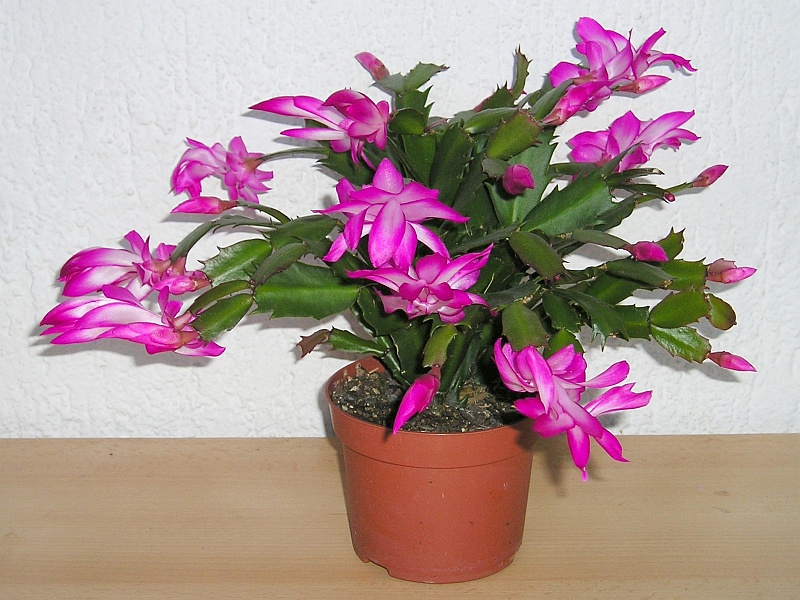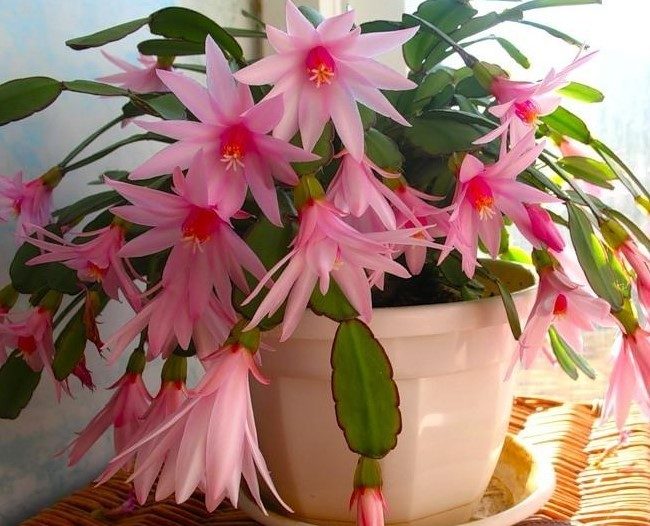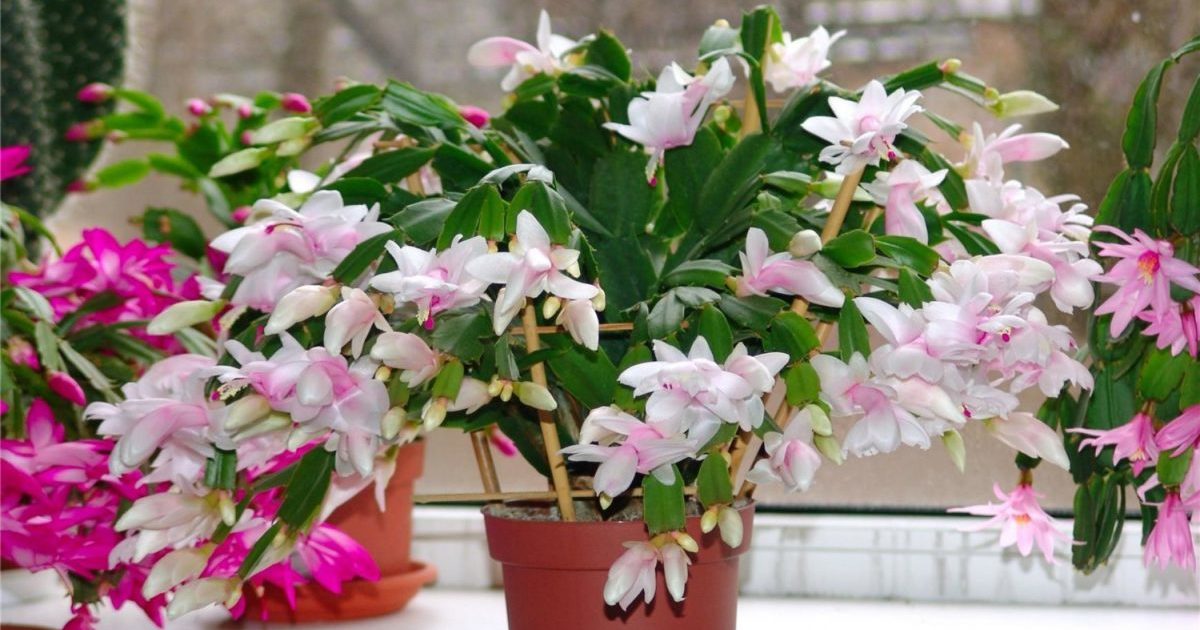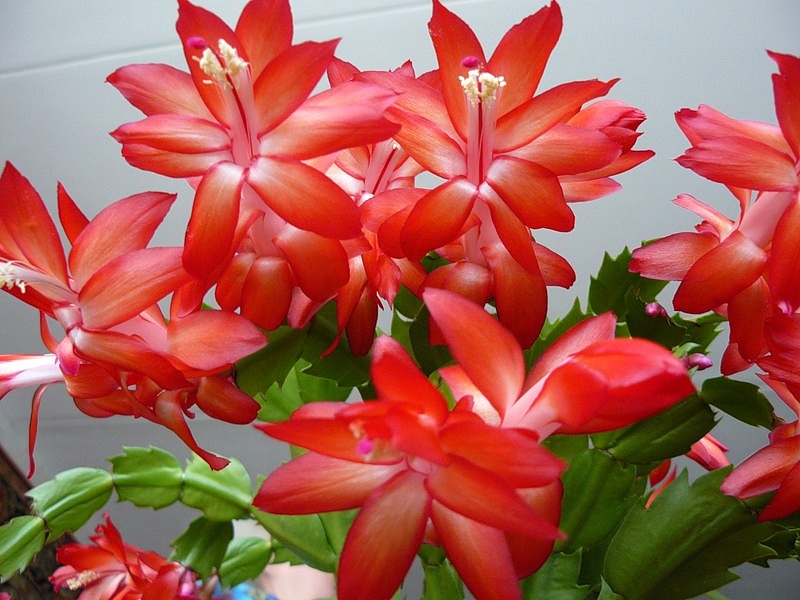Schlumbergera (zygocactus) is a variety of cacti that live in the tropical climate of Brazil. Representatives of the genus lead an epiphytic lifestyle, growing in the forests on tree branches. The plant is often called the Christmas cactus or the Decembrist, because the flowering period begins on the eve of the Christmas holidays. Schlumbergera is grown as an ampel plant. Thanks to the green shoots with bright colors, the cactus looks great in hanging flower pots.
The most common among flower growers is this kind of schlumbergera, known to everyone Decembr, because caring for him at home it is quite simple, and the plant annually pleases owners with bright colors, even with minimal attention.
Content
Characterization of Schlumberger
Externally, the plant is not very similar to cacti - it does not have thorns, but from the point of view of botany, zigocactus is this species. He lives in the shade of tropical rainforests, so he does not need to store moisture for the future.
Christmas cactus is a small bush with many branches. Shoots of green color flattened and serrated at the edges. At the ends of the joint branches at the beginning of winter, elongated tubular flowers of white, red or pink color with a bunch of long stamens appear.
Schlumberger and Decembrist - is there a difference between them?
In our country, most often in apartments you can find two varieties of zigocactus: truncated Schlumberger and Bukley. The type of Bukley is called the Decembrist, because it blooms, as a rule, in December. The stems of the plant are formed from elongated segments with rounded protrusions. On drooping shoots up to 60 cm long, purple and pink buds grow.
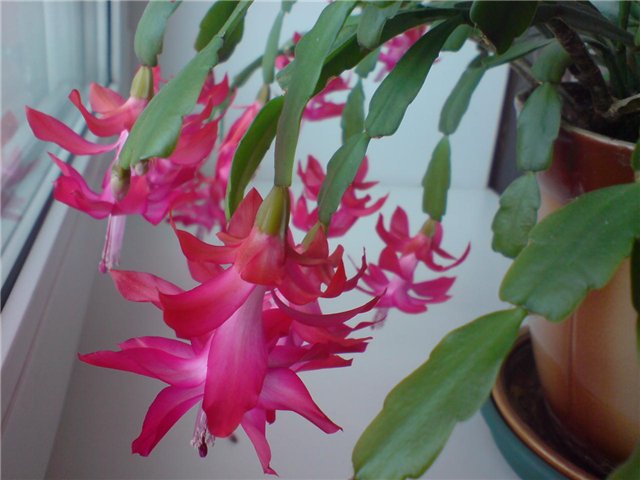
In addition to the Decembrist Bukley, on the windowsills you can often see truncated Schlumbergera. It is distinguished by serrated protrusions along the edges of the segments, and its long flowers are slightly beveled. Thanks to breeding work today, you can see the most diverse shades of petals: purple, pink, white and purple. The height of the bush usually does not exceed 40 cm. The stems are painted in a light green color, sometimes with a reddish tint.
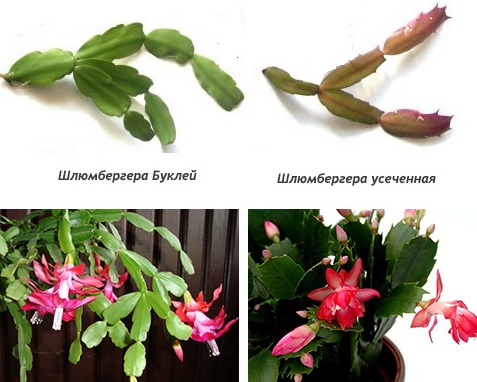
Other species
At home, zigocactus Russeliana is also grown, which has branched hanging shoots up to 1.2 m long. The central vein is pronounced on the surface of the segments. The edges of the segments are wavy, without spines. In the flowering phase, the plant produces pink, purple or burgundy flowers.
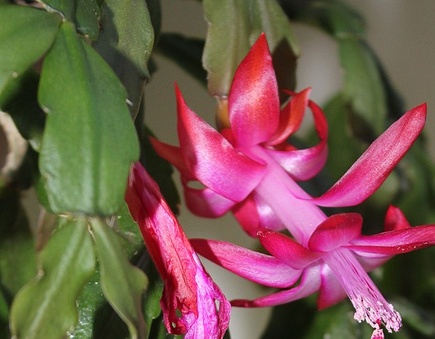
There are many hybrid varieties of zigocactus, among which growers distinguish the most interesting:
- Christmas Fantasy has a beautiful bush shape and salmon-colored flowers. This hybrid variety is very popular;
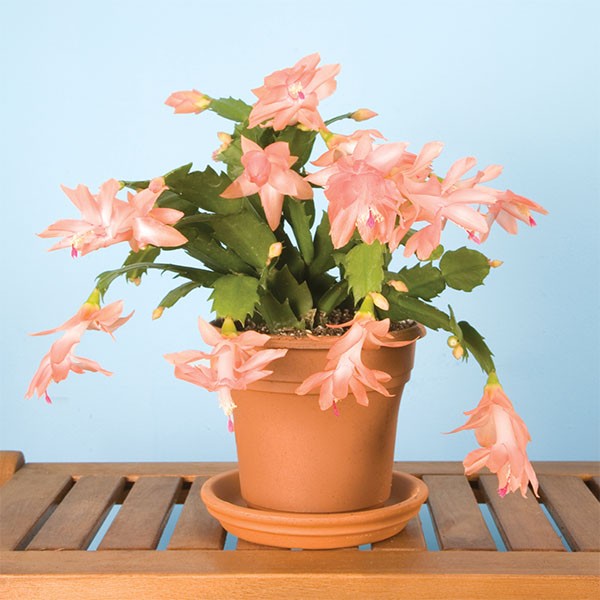
Christmas fantasy - White Christmas - a plant with white flowers. It has a longer flowering period than other varieties.
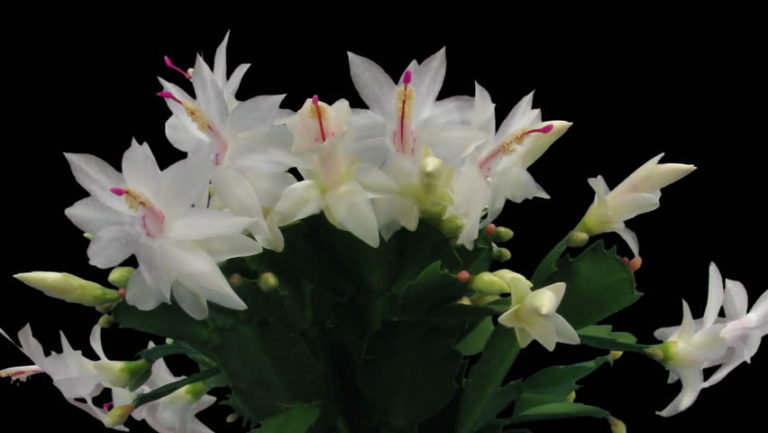
White christmas
Schlumberger maintenance and home care
To maintain zigocactus, the following conditions must be created: maintaining the necessary humidity, lighting and compulsory compliance with the rules of care during rest.
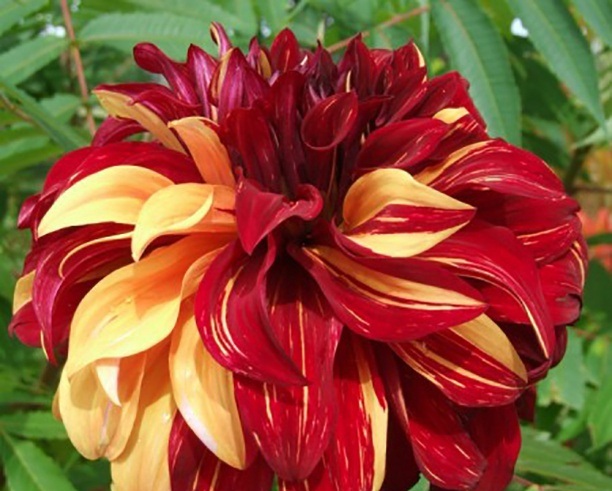 You may be interested in:
You may be interested in:Light and temperature
Beginning flower growers often believe that if the plant belongs to the Cactus family, then it needs a bright sun. This does not apply to Decembrist and other types of plants, because in the natural environment he lives in the shade of a rainforest. The place for the flowerpot should be selected constant, because the cactus is keenly sensitive to changing lighting (it can reset flowers and buds).

If the apartment does not have such an opportunity, then the flower is placed on the eastern or southern windowsill, but with mandatory shading. In the autumn-winter period, a decrease in solar activity contributes to the formation of flower buds, so there is no need for additional lighting.
The temperature of the room in which the flower lives should be constant and without sudden changes. The ideal temperature is considered to be 18-20 ° C. With the onset of heat, it is advisable to transfer the flowerpot to a balcony or veranda, but the temperature there should not drop below 13 ° C.
Watering and humidity
Schlumbergera grows in tropical forests, so at home she should create the most similar conditions. Since the plant is epiphytic, the moisture in the roots does not last long, which means that it should be watered often, but with a small amount of water. With the onset of the flowering phase, watering should be plentiful. At this time, it is important to monitor the condition of the soil, because excessive waterlogging can provoke rotting of the roots.
The moisture-loving flower responds well to regular spraying with warm, decanted water. The procedure is preferably carried out all year round, especially in the heating season. During the formation of the buds, the distance from the plant to the atomizer should be increased so that drops of water do not provoke decay of the tender buds.
Top dressing
In the summer, the Schlumberger is fed with nitrogen-containing fertilizers for cacti or universal fertilizers. The frequency of application of nutrients should not exceed twice a month. During flowering, the Christmas cactus can be fed with fertilizers for flowering crops.
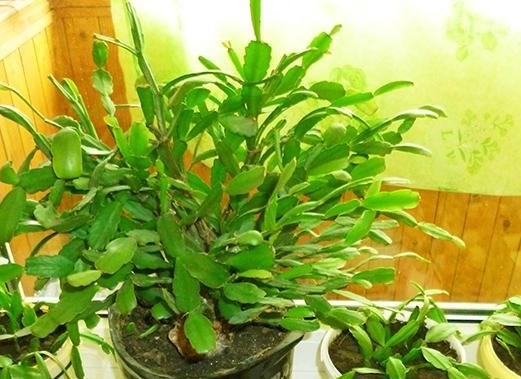
As a fertilizer, you can use eggshell:
- raw shells are well washed;
- fill with clean water;
- insist throughout the day.
Ready infusion can water the plant. Before the period of budding, it is advised to water the plant not with ordinary water, but with brewed tea at room temperature. After such irrigation, the Decembrist will not only bloom, but will also form much more flower buds.
Pruning
After flowering, the Schlumbergera can be cut to form a beautiful crown. The procedure is best done not with a sharp object, but with your hands plucking overgrown segments.
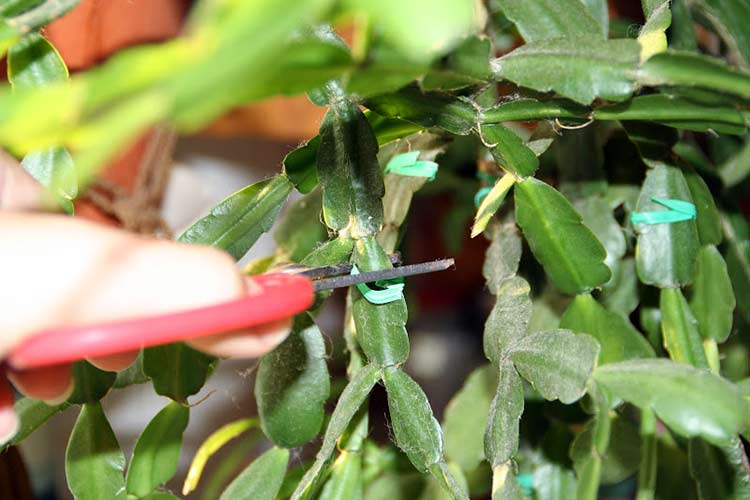
In the departments of floristry, you can sometimes see an unusual standardized schlumberger, which is obtained by vaccination. For this procedure, take Peirescia (also from the Cactus family), cut off its top, and insert a small Decembrist stalk into the section of the remaining stem. After all the manipulations, the vaccination site is fixed with a thread, which is removed after intergrowth.
Rest period
Since August, the plant begins to gradually move to the dormant stage, so the conditions of care should be slightly changed, because it is at this time that the plant gains strength for laying flower buds. The room temperature is reduced to 13-15 ° C, watering is reduced and top dressing is excluded. It is advised to use brewed tea as watering.
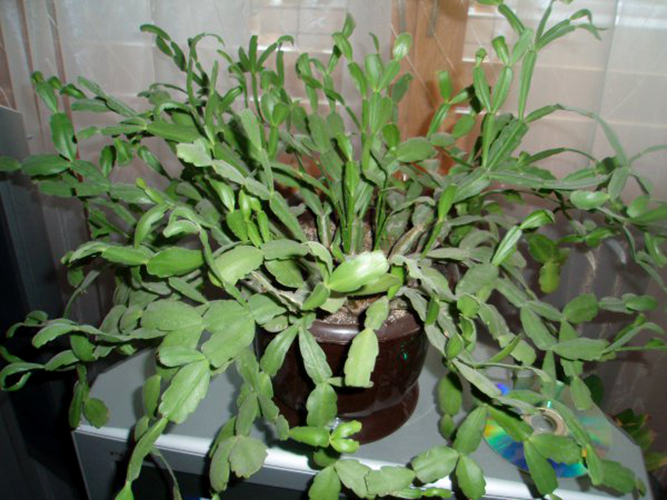
In October, more attention should be paid to the flower, because the abundance and duration of flowering depend on the October departure. Watering should be scarce, as well as lighting. At this time, you should often air the room. At the end of the month, it is advised to feed the flower with fertilizer for flowering plants, which contributes to long-term flowering.
 You may be interested in:
You may be interested in:How to propagate and transplant a flower at home
Schlumbergera perfectly lends itself to reproduction, which can be carried out using cuttings. Separate the cuttings with your hands, plucking several segments at the ends of the shoots.
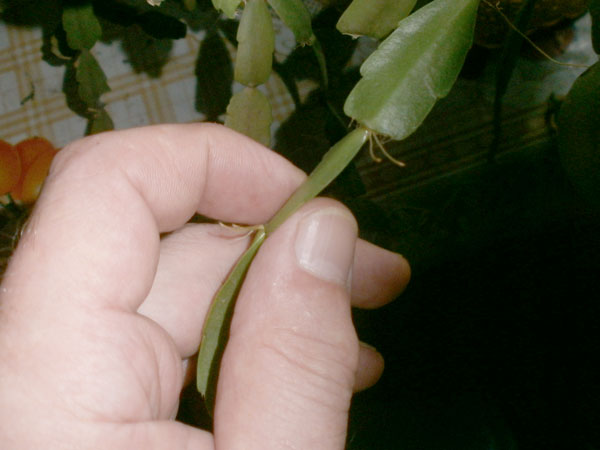
The separated part is left for a day so that it is slightly dried, after which it is planted in the soil for rooting. To avoid rotting of the segments, the stalk is not buried in the ground. It is placed in an upright position, propping up with toothpicks or leaning against the wall of the container.
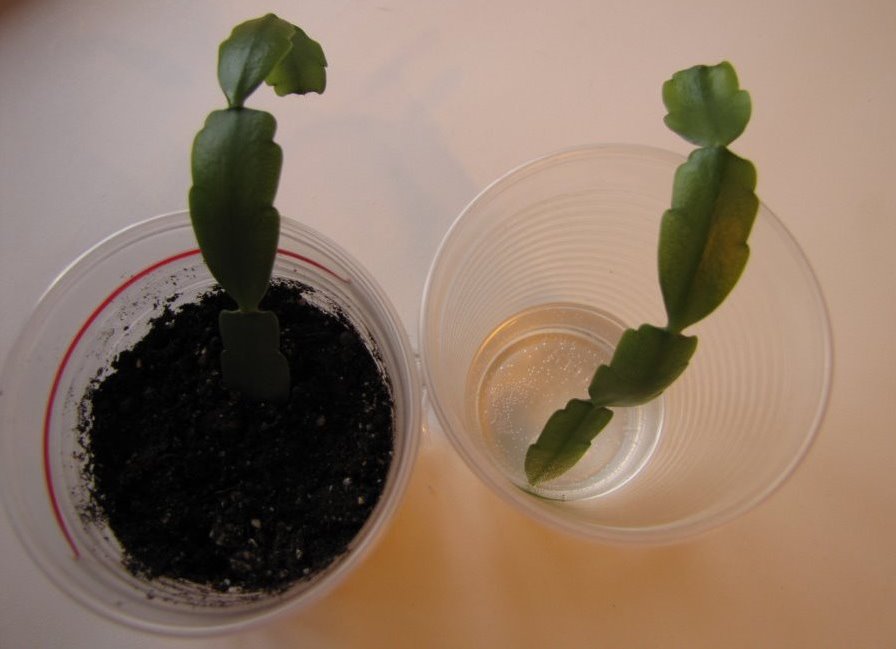
For transplantation, plants select a nutritious and loose soil mixture, the acidity of which should be in the range of 5.5-6.5. Zigocactus grows well in peat soil with the addition of sand, bark or small pebbles. The Decembrist grows best in the following soil mixture:
- sheet land - 1 part;
- turf land -1 part;
- charcoal and sand - 0.5 parts each.

Young Schlumbergera is transplanted after the flowering phase. The frequency of transplantation is once every 1-2 years. An adult bush needs a transplant once every 3-4 years. The flowerpot should be selected only a few centimeters more in diameter than the previous one. The capacity should be wide, but not deep, because the roots of the flower grow closer to the surface. The transplant procedure is carried out as follows:
- A layer of drainage and a little soil mixture are poured at the bottom of the new pot.
- Schlumberger carefully removed from the old container and gently shake off the soil.
- The plant is moved to the center of the new flowerpot.
- Holding the bush with your left hand, pour fresh soil into the container with your right hand.
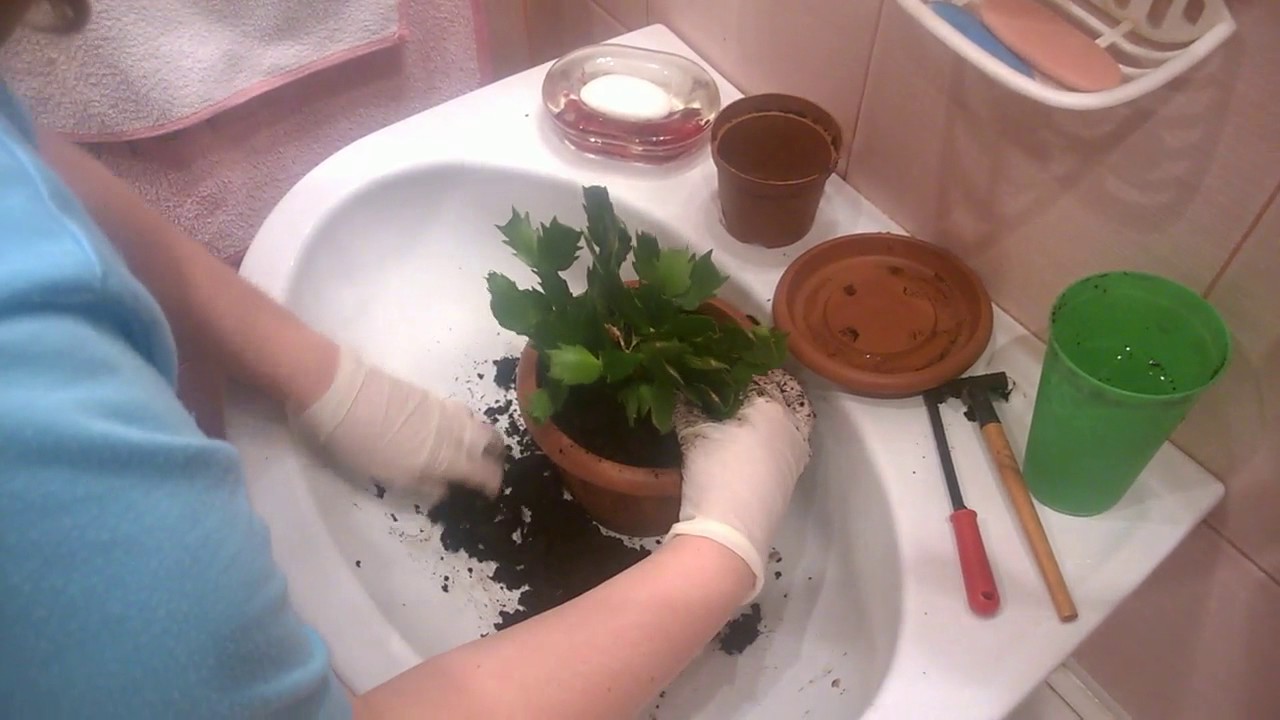
Transplant process - The soil does not need to be compacted, because after watering it will sit down, after which you can fill up the ground to the desired level.
The first watering is carried out only after three days. Water should be used warm and settled.
Diseases, pests of the Decembrist and the fight against them
Schlumbergera has good immunity, so with proper care it is extremely rare. The plant may be subject to fungal infections - late blight and fusarium. The affected plant begins to shed segments that acquire a pale green hue. The fight against infections consists in spraying the aerial parts with Skor or Topaz, and Maxim's solution is added to the water for irrigation.
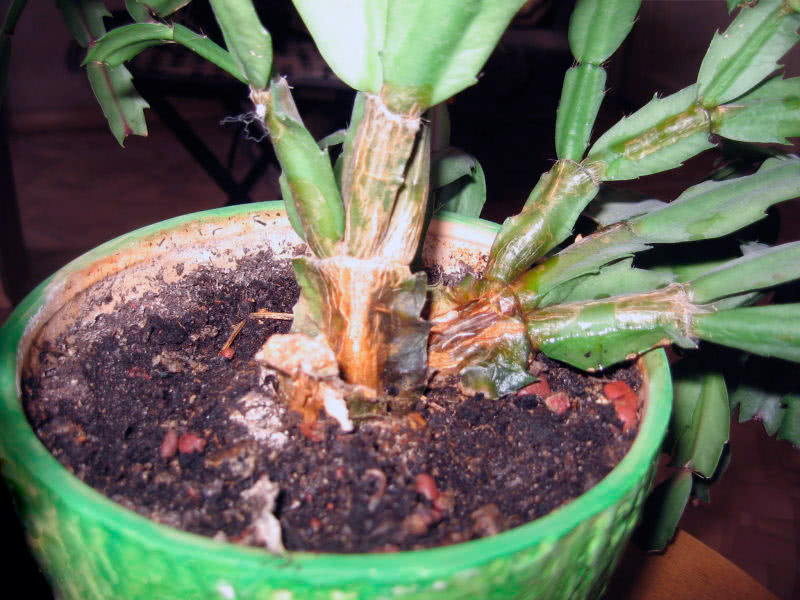
If small lumps of white color appeared on the flower, it means that mealybugs live on it. An insecticide (e.g. Aktar) should be used to control the pest. Of the insects on the surface of the schlumbergera, a spider mite can also settle.Affected plants become covered with a “rusty” coating and have a painful appearance. Special tools will help get rid of ticks: Fitoverm, Neoron, Actellik.
With high humidity, the scale can damage the flower - a small insect up to 5 mm in size. A pest can, in the full sense of the word, suck out all the juices from Decembrist, so you need to get rid of it immediately. Insects are collected using a cotton pad, previously moistened with alcohol or in a solution of Karbofos. For prevention, you can treat the green mass with an insecticide.
Common Growing Questions
Schlumbergera is a rather unpretentious houseplant. It is advised to grow even for beginners who only know the basics of floriculture. With minimal, but proper care, the flower will surely delight the owner with abundant and bright flowering for the Christmas holidays.

